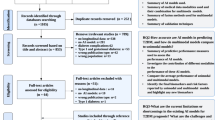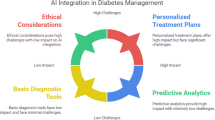Abstract
This study aimed to map the evolution and impact of artificial intelligence (AI) in diabetes prediction research from 2013 to 2023. Utilizing Scopus database records, a bibliometric analysis was conducted on documents featuring AI and diabetes prediction keywords. The analysis used the Bibliometrix and VOSviewer tools to evaluate research publication trends, author collaboration, and keyword co-occurrence in the application of AI in diabetes prediction. Data screening, focusing on specific terms in titles and abstracts, ensured the relevance of the documents. The study included diverse document types and subject areas, reflecting the field’s multidisciplinary nature. The findings revealed a significant annual growth rate of 84.86% in AI applications for diabetes prediction, with 1 498 documents from 802 sources highlighting strong scholarly interest. A peak in citation impact in 2018 marks key contributions and diverse research themes in that year. International co-authorship, notably from the USA, India, China, and Saudi Arabia, underscores extensive collaboration. Thematic analysis points to focal areas like ophthalmology in diabetes-related complications and identifies central topics and emerging trends, including the Internet of Things. The bibliometric review highlights a significant interdisciplinary expansion in AI research applied to diabetes prediction, with a marked increase in global collaborations and contributions. The study underscores the importance of AI in enhancing diabetes diagnostics and management, indicating a promising trajectory for future research, healthcare policy, and clinical practice. The evolution of AI, particularly machine learning, in diabetes prediction, demonstrates the potential for innovative solutions in managing this chronic condition.
Access this chapter
Tax calculation will be finalised at checkout
Purchases are for personal use only
Similar content being viewed by others
References
Wright, A.D.: What is diabetes? In: Diabetic Retinopathy: Screening to Treatment (Oxford Diabetes Library), pp. 1–6. Oxford University Press (2020)
Banday, M.Z., Sameer, A.S., Nissar, S.: Pathophysiology of diabetes: an overview. Avicenna J. Med. 10, 174–188 (2020). https://doi.org/10.4103/ajm.ajm_53_20
Egan, A.M., Dinneen, S.F.: What is diabetes? Medicine 47, 1–4 (2019). https://doi.org/10.1016/j.mpmed.2018.10.002
Shu, L.-Q., Sun, Y.-K., Tan, L.-H., Shu, Q., Chang, A.C.: Application of artificial intelligence in pediatrics: past, present and future. World J. Pediatr. 15, 105–108 (2019). https://doi.org/10.1007/s12519-019-00255-1
Zhou, H., Xin, Y., Li, S.: A diabetes prediction model based on Boruta feature selection and ensemble learning. BMC Bioinform. 24, 224 (2023). https://doi.org/10.1186/s12859-023-05300-5
Ayon, S.I., Islam, M.M.: Diabetes prediction: a deep learning approach. Int. J. Inf. Eng. Electron. Bus. 11, 21–27 (2019). https://doi.org/10.5815/ijieeb.2019.02.03
Fazakis, N., Kocsis, O., Dritsas, E., Alexiou, S., Fakotakis, N., Moustakas, K.: Machine learning tools for long-term type 2 diabetes risk prediction. IEEE Access 9, 103737–103757 (2021). https://doi.org/10.1109/ACCESS.2021.3098691
Sabitha, E.: Artificial intelligence approaches in diabetic prediction. Presented at the January 30 (2023)
Donthu, N., Kumar, S., Mukherjee, D., Pandey, N., Lim, W.M.: How to conduct a bibliometric analysis: an overview and guidelines. J. Bus. Res. 133, 285–296 (2021). https://doi.org/10.1016/j.jbusres.2021.04.070
Abdul, N.S., et al.: Applications of artificial intelligence in the field of oral and maxillofacial pathology: a systematic review and meta-analysis. BMC Oral Health 24, 122 (2024). https://doi.org/10.1186/s12903-023-03533-7
Aria, M., Cuccurullo, C.: Bibliometrix: an R-tool for comprehensive science mapping analysis. J. Informetr. 11, 959–975 (2017). https://doi.org/10.1016/j.joi.2017.08.007
van Eck, N.J., Waltman, L.: Software survey: VOSviewer, a computer program for bibliometric mapping. Scientometrics 84, 523–538 (2010). https://doi.org/10.1007/s11192-009-0146-3
Kermany, D.S., et al.: Identifying medical diagnoses and treatable diseases by image-based deep learning. Cell 172, 1122-1131.e9 (2018). https://doi.org/10.1016/j.cell.2018.02.010
Abràmoff, M.D., Lavin, P.T., Birch, M., Shah, N., Folk, J.C.: Pivotal trial of an autonomous AI-based diagnostic system for detection of diabetic retinopathy in primary care offices. NPJ Digit. Med. 1, 39 (2018). https://doi.org/10.1038/s41746-018-0040-6
Ting, D.S.W., et al.: Artificial intelligence and deep learning in ophthalmology. Br. J. Ophthalmol. 103, 167–175 (2019). https://doi.org/10.1136/bjophthalmol-2018-313173
Schmidt-Erfurth, U., Sadeghipour, A., Gerendas, B.S., Waldstein, S.M., Bogunović, H.: Artificial intelligence in retina. Prog. Retin. Eye Res. 67, 1–29 (2018). https://doi.org/10.1016/j.preteyeres.2018.07.004
Beede, E., et al.: A human-centered evaluation of a deep learning system deployed in clinics for the detection of diabetic retinopathy. In: Proceedings of the 2020 CHI Conference on Human Factors in Computing Systems, pp. 1–12. ACM, New York (2020)
Reddy, G.T., et al.: Analysis of dimensionality reduction techniques on big data. IEEE Access 8, 54776–54788 (2020). https://doi.org/10.1109/ACCESS.2020.2980942
Ting, D.S.W., et al.: Deep learning in ophthalmology: the technical and clinical considerations. Prog. Retin. Eye Res. 72, 100759 (2019). https://doi.org/10.1016/j.preteyeres.2019.04.003
Rajalakshmi, R., Subashini, R., Anjana, R.M., Mohan, V.: Automated diabetic retinopathy detection in smartphone-based fundus photography using artificial intelligence. Eye 32, 1138–1144 (2018). https://doi.org/10.1038/s41433-018-0064-9
Li, J.-P.O., et al.: Digital technology, tele-medicine, and artificial intelligence in ophthalmology: a global perspective. Prog. Retin. Eye Res. 82, 100900 (2021). https://doi.org/10.1016/j.preteyeres.2020.100900
Hasan, M., Alam, M., Das, D., Hossain, E., Hasan, M.: Diabetes prediction using ensembling of different machine learning classifiers. IEEE Access 8, 76516–76531 (2020). https://doi.org/10.1109/ACCESS.2020.2989857
Michael, G., Nancy, B., Michael, D.: Healthcare financing in Singapore. http://www.bioethicscasebook.sg/backgrounder/healthcare-financing-in-singapore/
Nadzar, N.M.A.M., Bakri, A., Ibrahim, R.: The study of co-occurrences index’s keywords for Malaysian publications. In: Saeed, F., Gazem, N., Mohammed, F., Busalim, A. (eds.) Recent Trends in Data Science and Soft Computing, pp. 161–172. Springer, Cham (2019). https://doi.org/10.1007/978-3-319-99007-1_16
Author information
Authors and Affiliations
Corresponding author
Editor information
Editors and Affiliations
Ethics declarations
Conflict of Interest
The authors declare that they have no competing interests.
Rights and permissions
Copyright information
© 2024 IFIP International Federation for Information Processing
About this paper
Cite this paper
Mbuya, E., Mokheleli, T., Bokaba, T., Ndayizigamiye, P. (2024). The Application of Artificial Intelligence in Diabetes Prediction: A Bibliometric Analysis. In: Chigona, W., Kabanda, S., Seymour, L.F. (eds) Implications of Information and Digital Technologies for Development. ICT4D 2024. IFIP Advances in Information and Communication Technology, vol 708. Springer, Cham. https://doi.org/10.1007/978-3-031-66982-8_1
Download citation
DOI: https://doi.org/10.1007/978-3-031-66982-8_1
Published:
Publisher Name: Springer, Cham
Print ISBN: 978-3-031-66981-1
Online ISBN: 978-3-031-66982-8
eBook Packages: Computer ScienceComputer Science (R0)





